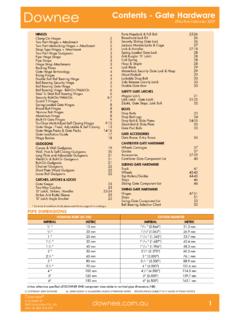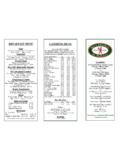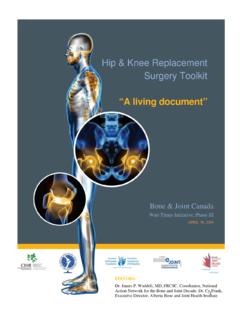Transcription of Animals and Adaptation - mysciencesite.com
1 Animals and Adaptation From: In order for Animals to survive, they need to be able to adapt. In this lesson we will look at the types of adaptations Animals can and do make. In a perfect world, Animals would not need to adapt. However, with constant changes to their environment, food chain and climate, Animals must adapt or face extinction. There are many examples of Animals facing extinction. Later on in the course we will take a look at some of these examples, and the reasons for their endangerment. Adaptation An Adaptation is a trait that makes an animal suited to its environment. It can be a behavioural or a structural trait. Here a some examples: Moving in large groups is a behavioural Adaptation ; it helps protect the members of the group from predators.
2 The thick fur coat of an arctic fox is a structural Adaptation . It helps protect it against the cold weather. Adaptation happens over a long period of time. Structural Adaptation happens in the form of changing an animal s genetic traits. Take for example this imaginary animal , the whatsit. The whatsit lives in woods. It s hunted by men and larger Animals . Most whatsits are born with white fur, making them easy to spot amongst the trees. Some whatsits are born with brown, speckled fur. These are far more difficult to spot. Since they are easier targets for hunters, far more white whatsits are hunted and killed than speckled ones. Each time a speckled one mates with a white one, half the offspring are speckled.
3 Eventually the amount of white furred ones available to breed is smaller than the number of speckled ones. More offspring are born with speckles than with white fur. This animal has adapted, and now the majority has speckled fur instead of white fur. Eventually the white furred ones will disappear altogether. There are many examples of this type of Adaptation . Because it happens over generations, it is slow. In some cases, the inability of Animals to adapt quickly enough have led to their distinction or endangerment. Behavioural Adaptation can happen far more quickly. The more intelligent an animal is the faster it can learn to make behavioural changes, in order to survive. If you take the most intelligent of Animals , you can understand what happens.
4 Humans adapt in many ways in order to survive. Here is an imaginary example of human Adaptation : A group of people lives in village Somewhere. In the village a large number of children die each year, after being attacked by wild Animals . The villagers can make changes to their environment and behaviour in order to protect the children. They can build fences around the village. They can make traps to catch the Animals . They can ensure that the children only go out in groups, protected by armed adults. All of these are behavioural changes, and can happen almost overnight. The speed with which they happen depends on the intelligence of the Animals and their ability to work as a community. The Best Adaptations Adaptation can work in two ways.
5 The best example of this is camouflage. A chameleon can change its colour according to its surroundings. Think about how this helps protect it. Not only does it help protect the chameleon, it also helps it survive in another way. Because it blends in so well with its surroundings, insects are less likely to see or notice it. By blending in it also makes it a better hunter, it can hunt without being seen, In fact, it is such an efficient Adaptation that hunting is probably the wrong word o use. It just blends in and patiently sits waiting for some unsuspecting insect to happen along. Then, flick, out goes the tongue and there is one less insect and one less hungry chameleon. The more ways a single Adaptation helps an animal to survive, the better it is.
6 Going back to the arctic fox and its fur coat. How can that coat help the fox in more than one way? The answer lies in the colour of the coat. Obviously in a landscape covered in snow, a thick, white coat is very useful. This Adaptation works in three ways. It protects the fox from the cold ad provides camouflage. The camouflage allows it to hunt more efficiently and hide from would-be predators. Penguins In order to understand the adaptations penguins have, we first need to look at some of the characteristics of all birds. Birds have their feathers in rows, with spaces in between. In order to fly they need extra light bones. They have extra air spaces in all their bones to make them lighter. The arrangement of bones in the hand makes them very flexible, which helps with flying.
7 Birds are very lean; this means they have very little fat. Some Penguins live in the Antarctic, where it is extremely cold, and the water temperatures never rise above freezing. Others live further North, but all penguins live in the Southern Hemisphere. The furthest North that Penguins live is in the Galapagos Islands. Some Penguins (Emperor Penguins) never step on land. When they are not in the water they live on ice floes. All penguins are flightless. They cannot fly at all, but they are wonderful swimmers. In Penguins the wing is known as a flipper. Structural Adaptations: They are white on the front and black on the back. In water, the only place they are really at risk from predators, this gives them camouflage.
8 From below they are white and cannot be easily seen against the lighter surface of the sea. From above they blend in with the darker depths. Penguin feathers are extremely densely packed, with no gaps between them. This gives them good protection against the cold. Each feather has an extra part behind it, so that they can fluff their feathers up. This keeps them warm in the cold and allows them to cool off when the weather is warmer. They don t have all the extra airspaces in their bones that normal birds have. This helps them sink in the water. They have a layer of blubber (fat) beneath their skin. This helps them keep warm. They can control the flow of blood through the fat. When it is very cold almost no blood passes through the fat.
9 When they are warm, the blood flow increases so they can cool off. The hand bones are fused (stuck) together. This is because water is thicker than air, and in water the flexible arrangement of flying birds would not make the wings strong enough to pull them through water. Emperor and King Penguins have a special flap of skin on their feet. They do not build nests from twigs and leaves. They only lay one egg, and keep it on their feet, under the flap of skin so it can t roll off. The feathers come down over the feet, keeping the egg warm. Behavioural Adaptations: Penguins live in large communities. This helps keep them warm. They make their nests side by side and after the chicks are born they all huddle together to stay warm.
10 Living close together in large communities also protects them from the few predators, who might like to make a meal of them. Any walrus or sea lion happening upon them will only be able to grab one penguin from the edge of the group. Penguins pick up stones and store them in their crop. This makes them heavier when they are in water. Neat Penguin Facts: 1. They are considered to be the most specialized Animals on the planet, and yet they are not endangered. 2. Penguin pairs share duties. The female builds the nest and lays the egg, while the male hunts and eats, this takes up to 3 weeks. Then the female hunts and eats, while the male sits on the egg. Once the egg has hatched both parents collect food and feed the young.







